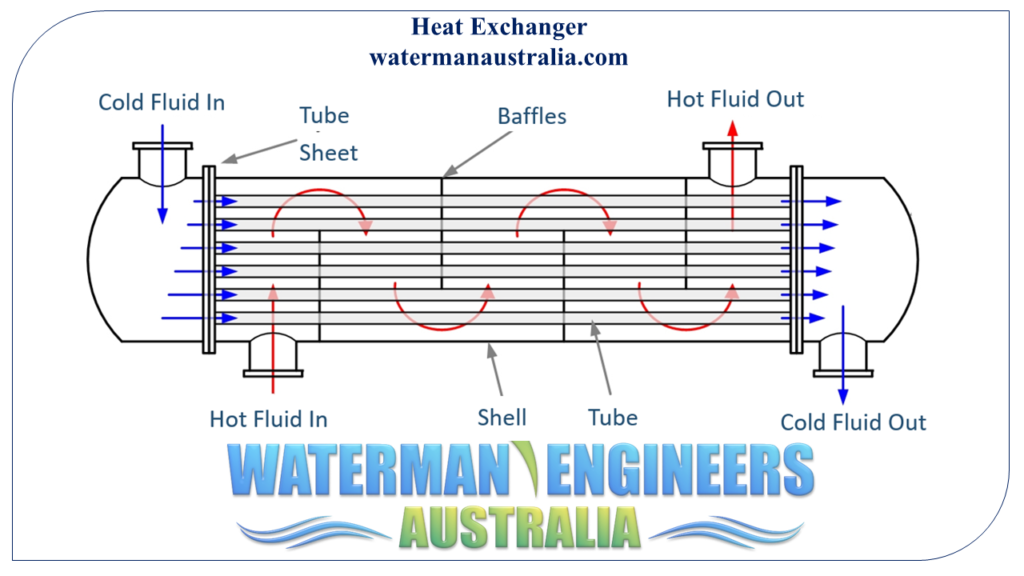
A heat exchanger is a device that allows for the transmission of heat between two different media without any physical contact between them. Heat exchangers work on the idea that thermal energy can be transferred from a hot fluid to a cold fluid. Heat exchangers provide for precise temperature regulation, improving energy efficiency and system functionality by transferring heat between two fluids.
Power plants, chemical plants, HVAC (heating, ventilation, and air conditioning) systems, supermarkets, and many more all employ heat exchangers. They can be found in commonplace home products like air conditioners and water heaters.
In this article, we'll learn about heat exchangers, what they are, how they work, and the different kinds there are. The article also details the common uses and factors to consider when choosing a heat exchanger.
Right after introducing the basic heat transfer ideas and parameters, an summary of design methodologies is reviewed. Subsequently, details of layout principle of various varieties of exchangers are presented. The main version proven alone because the typical one-quantity textual content on the subject. The 2nd edition preserves an established in-depth method but demonstrates some new technological developments linked to layout for producing compact heat exchangers, including novel 3-D printing strategies to heat exchanger design. Audience of the 2nd edition of Fundamentals of Heat Exchanger Design and style will even discover:
A technique to reduce air high quality and humidity troubles in a home, without the need of opening a window, is via the set up of the mechanical ventilation process for example an air-to-air heat exchanger.
A corrosive fluid need to be set about the tube side in an effort to minimize the quantity of costly corrosion-resistant content used.
For carbon metal S&T heat exchangers, the gear Expense is often estimated utilizing the rule of thumb of $500/m2 of heat exchange region.
Earlier mentioned 50–sixty°C an expansion joint will be necessary on the shell, which enhances the Price tag and is particularly a source of leakage eventually and should lead to a plant outage. It really is thus encouraged to only contemplate an growth joint at very low shell-facet force and for pipe-sizing shells. If this isn't the situation, a U-tube detachable bundle (BEU) really should be selected. The fouling fluid shall be switched into the shell side.
For your Manage volume at continuous condition, dEcvdt=0. Changes in the kinetic and probable energies from the flowing streams from inlet to exit could be ignored.
Despite this small worth—for an Office environment constructing and warm summer local climate—, to the design of the EAHX for standalone Designing of heat exchanger manufacturer Place of work place cooling it signifies a demanding prerequisite.
The pressurized components in the shell and tube exchanger are intended to be in accordance having a tension vessel structure code which include ASME VIII (1993) or BS5500 (1994).
S&T heat exchangers can be found in a variety of subtypes, referred to by three letters based on the TEMA benchmarks including “AES” or “BEM.” The main and also the third letters confer with the kind of the entrance and rear heads, when the middle letter, which is the shell variety, is critical for thermal style and design. It defines the circulation pattern from the shell-aspect stream through the exchanger.
exciting to viewers, or significant in the respective investigate location. The purpose is to deliver a snapshot of a few of the
The weld neck flange variety, which has a tapered hub having a easy anxiety changeover and accessibility for complete nondestructive examination, presents the best integrity of your 3 kinds. A flange is made up of 3 subcomponents: the flange ring, the gasket and also the bolting. The profitable operation with the flange is dependent upon the proper selection, structure and assembly of such subcomponents. The Heat Trade Design Handbook is made up of two chapters speaking about these aspects.
Pike AH (2012) Experimental determination of colburn and friction factors in small plate heat exchangers with large floor enlargement variables.
Tube cleansing that has a welded channel bonnet (TEMA front close B) would have to have the breaking and remaking on the channel nozzle flanges to help the channel to get eliminated. A flat head (TEMA entrance stop A) avoids this and permits the pipework to remain in position.
12. Expansion bellows. These may very well be required while in the shell of a set tubesheet exchanger or in the floating head of single tube pass floating head exchangers. They are talked over in more depth in Enlargement joints.